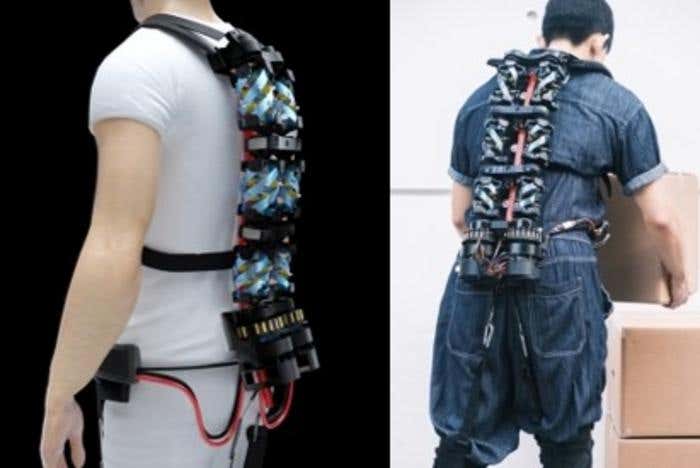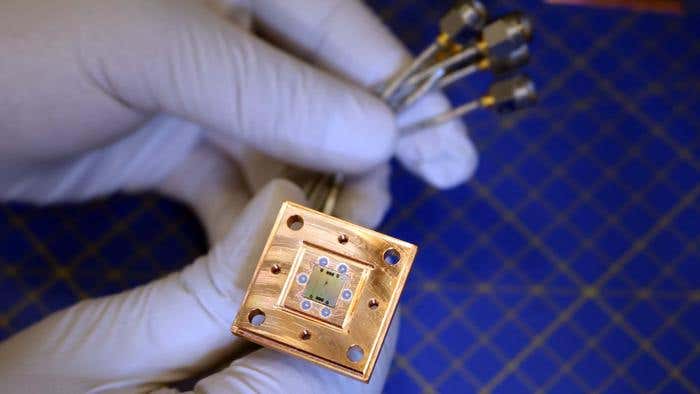Space-age exosuit is revolutionizing workplace safety and productivity
The BBEX, developed at Seoul National University, could significantly reduce workplace spinal injuries by offering multidirectional support for heavy lifting.

Design of the BBEX worn on a human user (left) and demonstration of weight lifting using the actual prototype (right) (CREDIT: Seoul National University College of Engineering)
A research team at Seoul National University, led by Professor Yong-Lae Park, has taken a major step in workplace safety with the development of the Bilateral Back Extensor Exosuit (BBEX). This robotic back-support device is designed to prevent spinal injuries and assist workers in lifting heavy objects.
A recent study in Science Robotics highlights the BBEX’s potential to improve on existing back-support devices, which often fail in complex lifting scenarios. By offering multidimensional support and prioritizing safety, the BBEX sets itself apart in the field of occupational health.
Lower back injuries are a significant problem in workplaces where heavy or repetitive lifting is required. These injuries not only cause physical pain but also lead to financial losses for businesses.
While various back-support devices have been introduced to address these problems, many don’t work well when lifting in non-ideal conditions, especially during asymmetric lifting—lifting objects unevenly or at odd angles, which is common in industrial environments.
The BBEX is different. It closely mimics how the human spine and muscles naturally work, providing support in multiple directions. This is crucial for industries where workers are often required to lift in less-than-optimal positions, which can strain the back and lead to injury.
Inspired by the structure of the human spine and erector spinae muscles, the BBEX is designed with multi-degree-of-freedom (DoF) architecture. This allows the device to move naturally with the spine.
Related Stories
The suit’s linear actuators are serially connected, so they work smoothly with the body, offering targeted assistance where it’s needed most. Whether workers are lifting symmetrically or asymmetrically, the BBEX can reduce the strain on muscles and spinal joints.
The research team tested the BBEX on eleven healthy men, having them perform lifting tasks while wearing the device. The results were encouraging.
The BBEX provided multidimensional assistance, meaning it helped the back muscles from multiple angles. Participants experienced less muscle fatigue, and the device also reduced compression forces on spinal joints, which are often a source of injury.
These findings are significant because they show that the BBEX can provide comprehensive protection in real-world work conditions. By reducing muscle fatigue and decreasing stress on the spine, this exosuit may play a key role in reducing lower back injuries in industries where lifting is a regular part of the job.
What sets the BBEX apart from traditional back-support devices is its ability to move naturally with the body. This is thanks to its design, which mirrors the human spine's flexibility. By combining human-inspired movement with advanced robotics, the BBEX enhances the ability to perform physically demanding tasks while prioritizing worker safety.
The long-term benefits of such a device are clear. As industries continue to look for ways to reduce workplace injuries and increase productivity, devices like the BBEX are set to play a critical role. By reducing the strain on the back during heavy lifting, the BBEX can help protect workers from long-term health issues.
The BBEX represents an important leap forward in back-support technology. Its ability to reduce muscle fatigue and protect the spine from injury makes it a valuable tool for industries that rely on manual labor. In a world where safety regulations are tightening and businesses are increasingly focused on employee well-being, devices like the BBEX could become standard in many workplaces.
While the initial study only involved a small group of participants, the results are promising. As more research is done and the technology is refined, the BBEX could be a game-changer in preventing workplace injuries and improving the quality of life for workers who engage in heavy lifting.
Note: Materials provided above by The Brighter Side of News. Content may be edited for style and length.
Like these kind of feel good stories? Get The Brighter Side of News' newsletter.
Joshua Shavit
Science & Technology Writer | AI and Robotics Reporter
Joshua Shavit is a Los Angeles-based science and technology writer with a passion for exploring the breakthroughs shaping the future. As a contributor to The Brighter Side of News, he focuses on positive and transformative advancements in AI, technology, physics, engineering, robotics and space science. Joshua is currently working towards a Bachelor of Science in Business Administration at the University of California, Berkeley. He combines his academic background with a talent for storytelling, making complex scientific discoveries engaging and accessible. His work highlights the innovators behind the ideas, bringing readers closer to the people driving progress.



